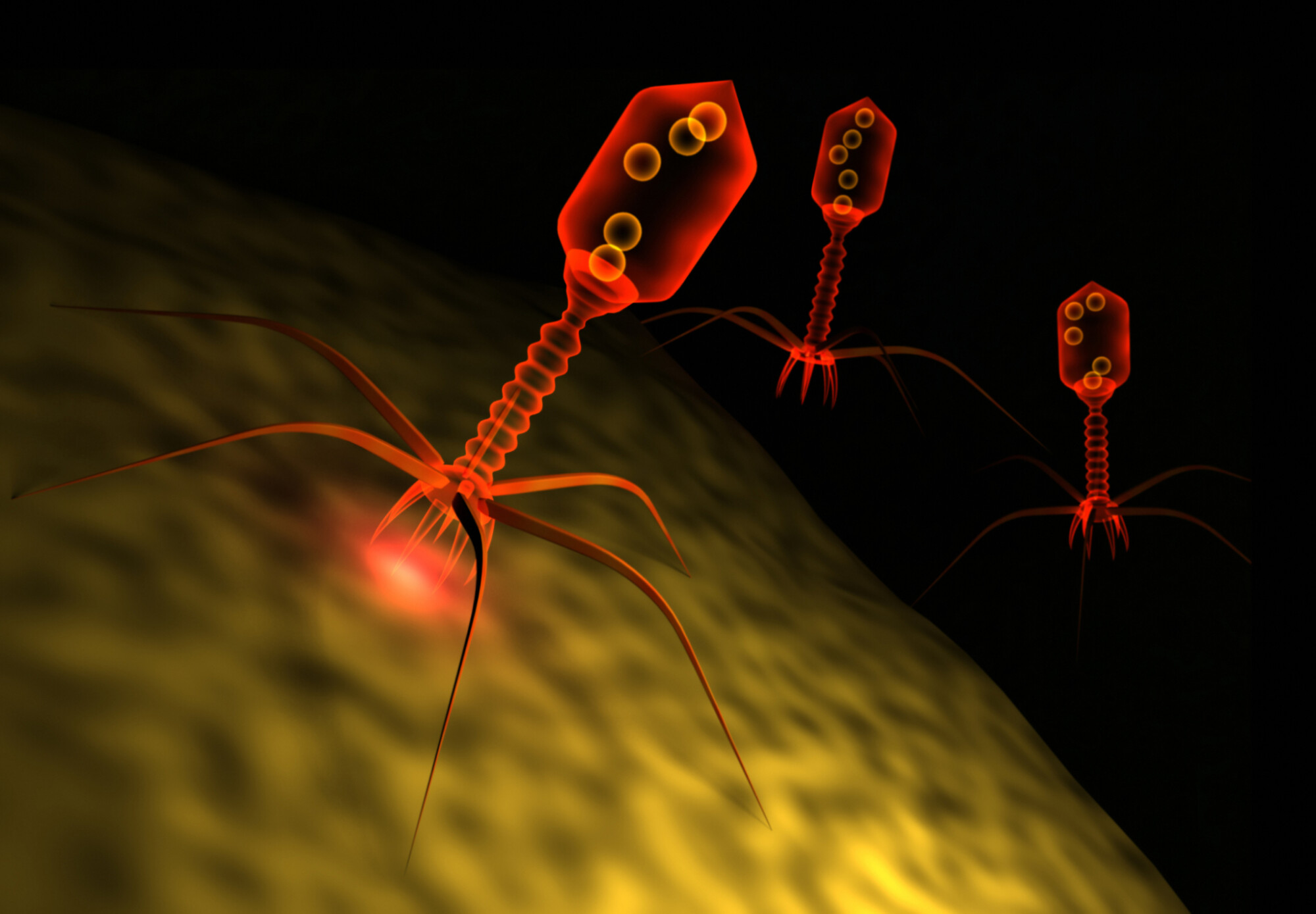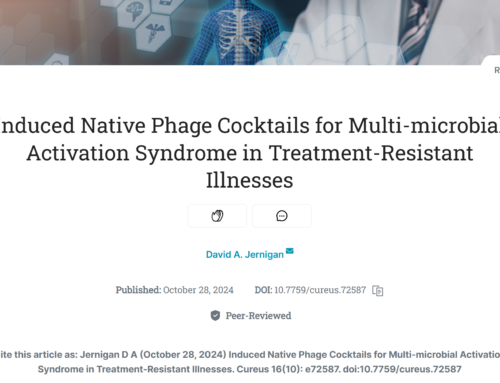Since my initial epiphany that led to the development of Induced Native Phage Therapy (INPT), in November of last year, we have seen amazing improvements in many our patients, and we have learned a lot about the world of phages and their effect on microbes of all types. After reading this, you will understand why we have never been more excited for people to come to the Biologix Center.
I want to summarize some of the things we have learned in the past four months.
- Phages are specific types of viruses that only infect a specific type of microbe…not human cells, therefore they do not cause illness in humans.
- Phages are everywhere. Phages are ubiquitous in nature and as an organism phages outnumber all other microbes, animals, and humans combined! They are so prevalent that if they were the size of lady bugs, they would completely cover the earth and be 31,000 miles (50,000 kiliometers) deep! If phages were the size of grains of sand they would cover the earth and be almost 50 miles (80 kilometers) deep!
- Every microbe on the planet, bacteria, molds/yeasts/fungi, parasites, and even other viruses get infected by phages.
- Phages, being viruses, cannot replicate (reproduce) by themselves, therefore they need a specific type of host. The phages hijack the genetic engine of their host by inserting the phage-genetic replication code into the host and the host starts manufacturing more of the phages.
- Phages are generally named after the host they infect, so a phage that only infects a bacterium is called a bacteriophage, a phage that only infects molds are called mycophages, a phage that infects other viruses are called virophages, and so on.
- There are innumerable types of phages on the planet. Each type of phage usually only infects one or two types of microbe, so the phages are often named more precisely by the type of microbe they infect. A phage that infects the primary bacteria that causes Lyme disease, Borrelia spirochetes, is called a Borrelia-phage. A phage that only infects Bartonella bacteria is called a Bartonella-phage. A phage that infects only Aspergillus mold is called an Aspergillus-phage, and so on. Our testing shows that each strain of a microbe, such as Borrelia burgdorferi and Borrelia hermsii need to be targeted individually.
- Phages are the dominant species in the human body. Only 43% of your body is human cells, the remaining 57% are microbes! There are are more bacteria in your body than there are cells. However there are up to a 100 times more phages in your body than there are bacteria.
- Phages do not infect human cells, or cause human illness even though they are viruses. Although phage do not infect human cells, they can enter human cells in order to kill the microbes that have infected your cells.
- Friendly flora, the good bacteria of your body could turn bad if they replicated to huge numbers. It is the phages that keep the good bacterial populations from growing out of control. Without being induced to kill the good bacteria, something that no one would do, phages only kill the usual 40%, which maintains a health homeostasis.
- There are ten million trillion trillion phages on the planet, causing a trillion trillion infections of host microbes…per second, killing half the bacteria on the planet everyday! Every microbe is already infected with phages. It appears from our research, and this is an important key finding, when a person becomes infected with a microbe such as Borrelia from Lyme Disease, or Strep bacteria, or Staph, or molds… those infections enter the body already infected themselves with phages! This is not published by any other researchers that I am aware of, it is more of a clinical theory based upon our in-house testing. It may also be possible for certain types of phages to be induced to go after a new type of host microbe. Phages can be induced to also kill the Lyme “persistor” cells/cysts.
- Phages kill microbes in two different ways, through lysis, or by lysogenic cycles. In lysis the phages land on their target microbe and essentially “cut” or cause lysis of the host’s cell membrane, which causes the microbe’s outer membrane to break apart. The other method phages kill their target microbe is by entering a lysogenic cycle, where the phage lands on the surface of the microbe and inject phage genetic material into the microbe causing the host to replicate so many phages inside of the host that it explodes, releasing the new phages to go find and kill more of that type host microbe. In this lysogenic cycle the target microbe’s genetic engine produces approximately 5200 new phages which then collectively produce an enzyme that causes the microbe to explode, releasing the new phages into the body to find more of that type of microbe to repeat the process. All the while the phages do not harm human tissues.
- INPT (Induced Native Phage Therapy), as developed at the Biologix Center, is believed to induce or stimulate large amounts of phages to activate against a specific microbe population. The greater the number of phages that are activated, the more likely the phages will choose to kill the microbe using lysis, which definitely kills the microbes more rapidly than the lysogenic cycle.
- Phages are a key unappreciated component of our immune system. Phages “farm” their hosts. In that phages need their specific host to replicate more phages, the phages unless specifically stimulated via our INPT system, seem to only kill about 40% of their host microbe. (Remember, you are not the host, since the phages only infect other microbes.) According to phage researchers, if a 100% of the host microbes are killed, the phages that need that specific host in order to replicate more phages will themselves die within about three days.
- With INPT it is not necessary to find phages from outside of the body to put into the body. All of the wealth of research on phages from around the world is based upon finding phages in nature and painstakingly researching to find or create phages that will kill the type of microbe causing a person’s illness. Now that we know that every infection in a human has a phage infection that can be induced to kill all of the infectious microbe, introducing phages from outside the body is unnecessary.
- Phages can reach microbes anywhere in the body, even crossing the blood-brain-barrier and can penetrate through bacterial biofilms and even can get inside the cells of the body to kill the microbes that are living inside your cells.
- Phages are extremely efficient killers when properly induced, such as with INPT, or with conventional phage therapy. Phages can kill all of a targeted microbe at times within 24-48 hours for some types of infections, and almost always appear to completely work to eliminate the targeted microbe within 5-7 days for larger bacterial populations, although research is still ongoing to verify this finding. The hyperlink is a picture of Taenia Solium tapeworms that were targeted with INPT phages. (If you are squeamish don’t look) The remarkable thing is the fact that these worms look like they have been dead for a few days, but in reality they were eliminated after only 5 hours of starting the INPT. It appears that the phages attacked the worms in the intestines from all sides, since the outer membranes of the worms is all fuzzy and broken down from apparent phage-induced lysis. No other treatments were give to this patient other than the INPT targeting of the worms. Not even the best pharmaceutical anti-parasitic medications can kill this quickly.
- The way phages kill a microbe causes much less “die-off” worsening of a person’s symptoms than antibiotics and other antimicrobial products. We now know from research that a “Herx” reaction is not actually from the bacterial guts spilling into the body as the bacteria are killed as with antibiotics. A Herx reaction is due to the proinflammatory cytokines released by the body’s immune cells that engulfed the dying bacteria. With phage killing of the bacteria the bacteria explodes where it sits and only the debris is cleaned up by the immune cells. The debris doesn’t cause much of a proinflammatory cytokine release and therefore the best treatment outcome is possible, faster and complete annihilation of the target microbe, with less worsening of the patient’s symptoms.
- Phage cure versus antibiotic remission. Remission is a temporary pause in an illness. Because antibiotics are reported to most often only ever kill up to 85% of the target bacteria, leaving 15% now treatment-resistant mutations of the original bacteria, the best that can be hoped for is remission, or that the human body can keep the rest of the microbes from causing more problems. Commonly, when the person is stress either physically, emotionally, chemically, or environmentally, or a combination of these, the body’s defenses weaken and the 15% returns with a vengeance. If and when phages can be induced to kill 100% of the target bacteria there can be no remission, since there are no more of the infecting bacteria to regenerate. The person would have to get reinfected in order to get ill once more. At this time, it is believed that there is no long-term protection from the phages if one were to get reinfected, since without the required host, the Borrelia, there is nothing to replicate more Borrelia-phages and therefore they would eventually die. Reinfection would require one to get the phages that came in with the infection to be induced (INPT) to kill all of the new infection once more.
- Phages can do more than just kill microbes. Recent research has identified a type of phage that can eliminate the plaques in the brains of people suffering from Alzheimer’s and Parkinson’s. Laboratory studies on rats with amyloid plaques on their brains were given a newly discovered phage called M13 and the phages cleared out almost all of the plaques and the rats memory and cognition returned.
- Laboratory testing has been developed that identifies the Borrelia-phages with a higher success rate of detection of the phages than the popular other types of Lyme disease tests.
- Human infections are often like having termites in the wood of your house. Simply killing the termites does not repair the damage that the termites cause in your house. The same is often true when phages kill all of a target infection in your body. Killing the infection, especially the chronic infection that has wreaked havoc in your body, will not repair the damage to the tissues. Often the body itself can repair the damaged tissues and health returns, however supportive treatments will often be needed before the true quality of life a person seeks can be achieved.




